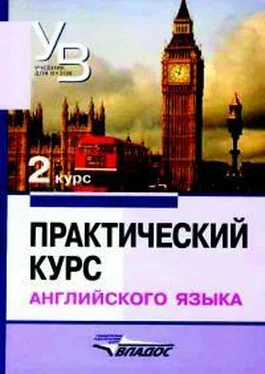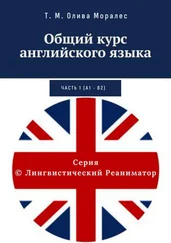Яков Аракин - Практический курс английского языка 2 курс
Здесь есть возможность читать онлайн «Яков Аракин - Практический курс английского языка 2 курс» весь текст электронной книги совершенно бесплатно (целиком полную версию без сокращений). В некоторых случаях можно слушать аудио, скачать через торрент в формате fb2 и присутствует краткое содержание. Год выпуска: 2005, Издательство: ВЛАДОС, Жанр: tbg_higher, на русском языке. Описание произведения, (предисловие) а так же отзывы посетителей доступны на портале библиотеки ЛибКат.
- Название:Практический курс английского языка 2 курс
- Автор:
- Издательство:ВЛАДОС
- Жанр:
- Год:2005
- ISBN:нет данных
- Рейтинг книги:3 / 5. Голосов: 1
-
Избранное:Добавить в избранное
- Отзывы:
-
Ваша оценка:
- 60
- 1
- 2
- 3
- 4
- 5
Практический курс английского языка 2 курс: краткое содержание, описание и аннотация
Предлагаем к чтению аннотацию, описание, краткое содержание или предисловие (зависит от того, что написал сам автор книги «Практический курс английского языка 2 курс»). Если вы не нашли необходимую информацию о книге — напишите в комментариях, мы постараемся отыскать её.
I - V курсов педагогических вузов.
Цель учебника – обучение устной речи на основе развития необходимых автоматизированных речевых навыков, развитие техники чтения, а также навыков письменной речи.
Практический курс английского языка 2 курс — читать онлайн бесплатно полную книгу (весь текст) целиком
Ниже представлен текст книги, разбитый по страницам. Система сохранения места последней прочитанной страницы, позволяет с удобством читать онлайн бесплатно книгу «Практический курс английского языка 2 курс», без необходимости каждый раз заново искать на чём Вы остановились. Поставьте закладку, и сможете в любой момент перейти на страницу, на которой закончили чтение.
Интервал:
Закладка:
XIX. Translate the following putting it in your own words. Comment on what yon have read:
XX. Arrange a talk on the following topics
XXI. Translate these sentences:
XXII. Try your hand at teaching.
1. The situation gives below could cause difficulties for the teacher. Describe how you would handle the situation in the teacher's position. Decide amongst your group which is the most practical solution;
2. Learn to use alternative ways of controlling the class, using polite requests rather than direct commands.
Assignments:
1. Practise giving instructions to pupils in a polite manner, use the phrases below:
1. Listen to the text "Anne Meets Her Class", mark the stresses and tunes, repeat the text following the model.
2. Respond as shown in the models, check your replies.
3. Combine the sentences into one conditional sentence.
4. Write a spelling-translation test:
a) Translate the given phrases into English.
b) Check them with the key.
5. Answer the questions using the phrases "to like the idea/dislike the idea".
6. Translate the given sentences into English. Check your sentences with the key.
7. Listen to the Jokes connected with school life. Get ready to retell them in indirect speech.
TOPIC: CHOOSING А CAREES
I. a) Transcribe and learn to read the following words:
b) Study Texts A and В and explain the meaning of the words and word combinations listed below:
II. a) Write English equivalents of the following words and phrases. Use them in sentences of your own:
b) Find in Text A synonyms to the following words and word combinations:
III. a) Enlarge upon the following topics:
b) Comment on the quotation from John Steinbeck, say if you share his opinion. Do you also think that teaching equals art? Why do you think that! Find more quotations concerned with teachers and teaching, comment on them.
c) Continue the text on the part of the teacher. You may find the following ideas useful:
d) Prepare a 3-minute talk on one of the great teachers of the past or today, give reasons for your choice.
IV. a) Act out the dialogue "Choosing is not so easy as it looks".
b) Role-play a talk between an intending teacher and a will-be journalist on differences and similarities of the careers they've chosen. Use Text В and Essential Vocabulary П.
V. Speak about:
1. possible change in the system of secondary education in Russia.
2. an ideal school as you see it.
VI. Bead the jokes below. See how the verbs learn and study are used in the context. Consult a dictionary and find out the difference in their meaning and usage. Retell the jokes in indirect speech:
VII. Translate the sentences using the words learn and study in their different meanings:
VIII. Comment on the given proverbs. Make np a situation centered round one of them:
IX. a) Fill in prepositions and adverbs where necessary:
b) Tell your friends how John chose his career.
c) Make up your own dialogues on choosing a career. Use the word combinations in bold type in them.
X. a) Read the following:
b) Support the idea with information from Russian and/or foreign press. Pay special attention to the situation in the USA and Great Britain.
c) Speak on:
XI. Here is a series of extreme opinions. Build a conversation about each topic. Begin as in the model:
Opinions:
XII. Translate the sentences below into English. Use Essential Vocabulary II:
ХIII. Role-piaying. a) Act out in pain the following situations; use Essential Vocabulary II:
b) Role-play the following situation:
XIV. Pick one of these topics and discuss it, making sure each member of the group gets a chance to speak;
XV. a) Read and translate the text:
b) Answer the questions below:
XVI. Act as an interviewer. Let the rest of the group speak about why and how they decided to qualify as a teacher of languages. Find out:
XVII. Interview a teacher at the school where you have school practice. Ask him or her the questions from Exercise XVI and also try to find out:
Discuss the interviews in class.
XVIII. Comment on the picture. You may find these phrases useful:
Assignments:
1. Read the text "Anne Meets her Class" and point out the paragraph» of description, narration, argumentation and exposition. What does the author like to describe in this episode? What is he telling the reader about? What argument is Anne thinking of to manage the class? What is Miss Enderby trying to explain to Anne?
2. Search Texts А, В (Р. II) for the basic forms of treating the topic "On Teaching" and prove your selection of paragraphs.
3. Write a paragraph describing the picture suggested by the teacher.
4. Write a short paragraph about your visit to a former schoolmate.
5. Write a paragraph supporting or arguing Jane's and Bob's idea about teaching. (See the Dialogue.)
1. a) Listen to the additional text "What's Your Line?" on the topic "Choosing a Carrer", mark stresses and tunes, practise reading the text.
b) listen to the dialogue and learn it by heart.
2. Respond as in the models. Check your replies.
3. Write a spelling-translation test, check it with the key.
4. Write the dictation "Five Hundred Years of English Language Teaching", check your spelling with a dictionary.
5. Translate the sentences into English, check your translation with the key.
6. a) Listen to the text and find English equivalents to the given words and word combinations.
b) Check the words and word combinations.
c) Listen to the text again and do the tasks after it.
UNIT TWO
EXERCISES I. Change these sentences, using Patterns 1a and 1b:
II. Combine the fallowing sentences into one, using speech Pattern 1c:
III. Make up sentences after Patterns 2 and 3, using the following words and phrases:
IV. Translate these sentences into English, using the patterns from Units One and Two:
V. Make up a dialogue, using the patterns from Units One and Two.
TEXT. A DAY'S WAIT by Ernest Hemingway
1. Read the text and the Notes on Lexicology and Style and talk on the following points (A. Grammar, B.Word usage, C. Style):
II. a) Choose the best translation of each English sentence below (or give your own variant) and reason oat your choice;
b) Translate the description of the father's walk.
III. a) Copy, transcribe and give Russian equivalents of these words:
b) Give the four forms of the verbs:
c) Make four columns and write numbers I, П, III and IV at their tops to represent four types of syllables. Then pick out from the list above ('a' and 'b') words with vowel sounds illustrating different types of syllables and place them in right columns.
IV. Try your hand at teaching.
(Look up the words and phrases you may need to do the task in "Classroom English", Sections IV, VIII.)
V. Answer the questions:
Begin when possible your answers with:
VI. Study Vocabulary Notes and a) write derivatives or compounds of:
b) Give the opposite of:
c) Give English equivalents of these words and use them in sentences of your own:
VII. Fill in
a) ache, hurt, pain, painful:
b) in, on:
c) refuse, give up:
d) like, as:
VIII. Write 5 questions after each pattern below. (Keep to the same word order.) Discuss them in class:
IX. Retell the text in reported speech following the outline given below:
Use the vocabulary of the text and the words:
X. Supply articles where necessary:
XI. Make up short dialogues starting with the sentences below. Try and argue with each other:
Use such phrases as;
XII. Translate into English;
ХIII. а) Fill in prepositions or adverbs where necessary and summarize the passage:
Читать дальшеИнтервал:
Закладка:
Похожие книги на «Практический курс английского языка 2 курс»
Представляем Вашему вниманию похожие книги на «Практический курс английского языка 2 курс» списком для выбора. Мы отобрали схожую по названию и смыслу литературу в надежде предоставить читателям больше вариантов отыскать новые, интересные, ещё непрочитанные произведения.
Обсуждение, отзывы о книге «Практический курс английского языка 2 курс» и просто собственные мнения читателей. Оставьте ваши комментарии, напишите, что Вы думаете о произведении, его смысле или главных героях. Укажите что конкретно понравилось, а что нет, и почему Вы так считаете.





![Владимир Аракин - Практический курс английского языка 3 курс [calibre 2.43.0]](/books/402486/vladimir-arakin-prakticheskij-kurs-anglijskogo-yazyk-thumb.webp)






